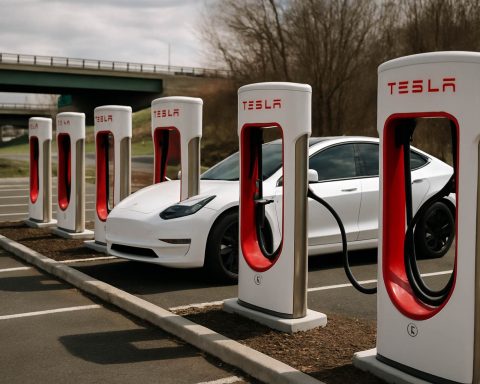- BYD achieved a significant milestone with 377,420 NEV sales in March, marking a 24.78% increase over the previous year.
- The sales included 166,109 pure electric vehicles and 205,310 plug-in hybrids, with PHEVs experiencing a 26.95% year-over-year increase.
- BYD’s first-quarter NEV sales reached 1,000,084 units, up 59.81% from the prior year, showcasing its competitive edge.
- Unlike Tesla, which faces challenges, BYD has embraced a strategic pivot away from internal combustion engine vehicles since March 2022.
- Commercial vehicle sales surged by 624.76% in March, demonstrating BYD’s market diversity.
- BYD’s presence in Australia strengthened, surpassing 40,000 sales in just over three years, with the Shark 6 PHEV ute and Dolphin Essential EV leading the charge.
- BYD sets the pace for sustainable mobility, highlighting strategic foresight and technological innovation.
In a dramatic shift that underscores the relentless surge of the electric vehicle (EV) wave, China’s automotive powerhouse BYD has rocketed past the competition with staggering sales figures that paint a vivid picture of its unstoppable momentum. With a dazzling array of new energy vehicles (NEVs), the company has crossed a significant milestone by selling 377,420 units in March alone, sending ripples across the global automotive landscape.
These numbers reflect BYD’s unprecedented ascent, marking a 24.78% increase compared to March 2024 and a robust 16.9% leap over February of this year. The dynamic duo of full battery-electric vehicles and innovative plug-in hybrids dominates this achievement. The company has recently captivated the market with models like the Shark, a hybrid utility vehicle, that stand as testaments to its engineering prowess. This impressive fleet included 166,109 pure electric cars and 205,310 plug-in hybrids (PHEVs), with the latter category surging by a staggering 26.95% year-on-year.
As the first quarter of 2025 concludes, BYD’s NEV sales tallied a remarkable 1,000,084 units—an awe-inspiring 59.81% rise year-on-year. However, in a seasonal ritual familiar to the Chinese automotive industry, sales typically dip during the early months of the year, as celebrations of the Chinese New Year take precedence.
While BYD races forward, international competitors like Tesla face an uphill battle. The American EV giant navigates a turbulent path, compounded by CEO Elon Musk’s political statements, which have triggered the recalibration of sales forecasts. Analysts now predict Tesla’s sales for the quarter might stutter at the 300,000 mark, a notable descent from ambitious initial projections hovering around 440,000.
Unlike Tesla’s tempestuous journey, BYD has resolutely turned a page in its corporate history. Since March 2022, BYD has entirely phased out the production of internal combustion engine (ICE) vehicles, channeling its energy exclusively into electric and plug-in hybrid technology. This strategic pivot has equipped the company with an expanding market share in regions as diverse as Australia, where its electric dreams have taken root firmly.
Amidst these figures, one statistic truly stands out: commercial vehicle sales are not just an afterthought for BYD. In March, this sector surged by 624.76% year-on-year, albeit on a smaller base, demonstrating BYD’s prowess in diverse segments of the electric market.
BYD continues to cast its net wider, with its presence in Australia blossoming. Just over three years in, the company announced its 40,000th vehicle sale in the Australian market. As 2025 unfolds, the company anticipates crossing this threshold again within the calendar year, bolstered by its heartening portfolio that includes Australia’s first PHEV ute, the Shark 6, and the affordable Dolphin Essential EV, breaking price barriers at just $29,990.
As electric vehicles reshape automotive destinies, BYD’s narrative is more than just numbers. It is a tale of strategic foresight, agile adaptation, and technological ingenuity that challenges and inspires global industry benchmarks. In an arena that demands innovation at every turn, BYD stands tall as a beacon of what the future holds for clean and sustainable mobility—a future that promises to leave a lasting impact on roads worldwide. The takeaway is clear: in the race towards an electrified tomorrow, BYD is not merely keeping pace; it is setting the agenda.
Unveiling BYD’s Electrifying Rise: What You Need to Know for 2025
BYD’s Strategic Triumphs in the Electric Vehicle Industry
In the competitive landscape of electric vehicles (EVs), BYD stands out as a dominant force, reshaping the global automotive market with its remarkable sales figures and strategic innovations. Having sold 377,420 units in March alone, the company has secured its position as a leading manufacturer of new energy vehicles (NEVs). With an impressive year-on-year sales increase of 59.81% by the first quarter of 2025, BYD demonstrates its successful pivot from traditional internal combustion engine vehicles to electric and plug-in hybrids.
Additional Insights and Trends
1. Rigorous Market Expansion:
– Global Reach: BYD has actively expanded its market reach beyond China, establishing significant footholds in regions such as Australia, where its EV sales have surpassed 40,000 units within a mere three-year span.
– Diverse Fleet: Introduction of varied models like the PHEV ute, the Shark 6, and the affordable Dolphin Essential EV underpins its diverse product lineup, catering to different consumer needs and preferences.
2. Technological Advancements:
– Battery Innovation: BYD’s breakthrough in battery technology, particularly with Blade Battery, offers enhanced safety, longer lifespan, and cost-efficiency, setting new benchmarks for EV manufacturers.
– Plug-in Hybrid Dominance: The surge in plug-in hybrids, rising by 26.95% year-on-year, reflects consumer interest in versatile, efficient vehicle options that provide benefits of both electric and conventional driving.
3. Commercial Vehicle Sector:
– Emerging Leader: Despite originating from a smaller base, BYD’s commercial vehicle sales burgeoned by over 624% in March, emphasizing its potential to disrupt not just the consumer vehicle segment but also commercial transportation.
Real-World Use Cases and Market Prospects
– Sustainability Initiatives: As businesses worldwide shift toward green fleet solutions, BYD’s commercial and consumer EVs present viable options for companies looking to reduce their carbon footprint.
– Integration in Public Transport: With electric buses and other public transport solutions, BYD could leverage city partnerships to enhance sustainable urban mobility.
Comparison: BYD vs. Tesla
– Market Position: While Tesla remains a pioneer in the global EV market, BYD’s strategic focus on diversification and market-specific adaptations provides it with a unique competitive edge, especially in Asian markets.
– Growth Trajectory: Unlike Tesla’s recent sales recalibration due to external influences, BYD shows an upward trend supported by actionable strategies like eliminating ICE vehicles, thus aligning with environmental goals.
Industry Predictions
– Global Leadership Potential: With its aggressive market entry in various continents and continued innovation, BYD is poised to become not only a key player but potentially the leader in electric mobility worldwide.
– Sustainable Mobility Trends: As cities globally endorse EV adoption, BYD’s model diversification and affordability are likely to position it favorably in the race towards a decarbonized future.
Actionable Recommendations
– Embrace EV Transition: Consumers and businesses should consider BYD’s extensive model range for reliable, cost-effective, and environmentally friendly transportation solutions.
– Stay Informed: Regularly explore emerging trends in EV technology and market changes to make informed purchase and investment decisions.
For more information on electric vehicles and sustainable mobility, visit BYD’s website at BYD.
In conclusion, BYD is setting the pace in the EV revolution, illustrating that innovation, strategic focus, and adaptability are key to redefining modern transportation. As the industry evolves, keeping up with BYD’s momentum may be the key to staying ahead in the electrified future.










